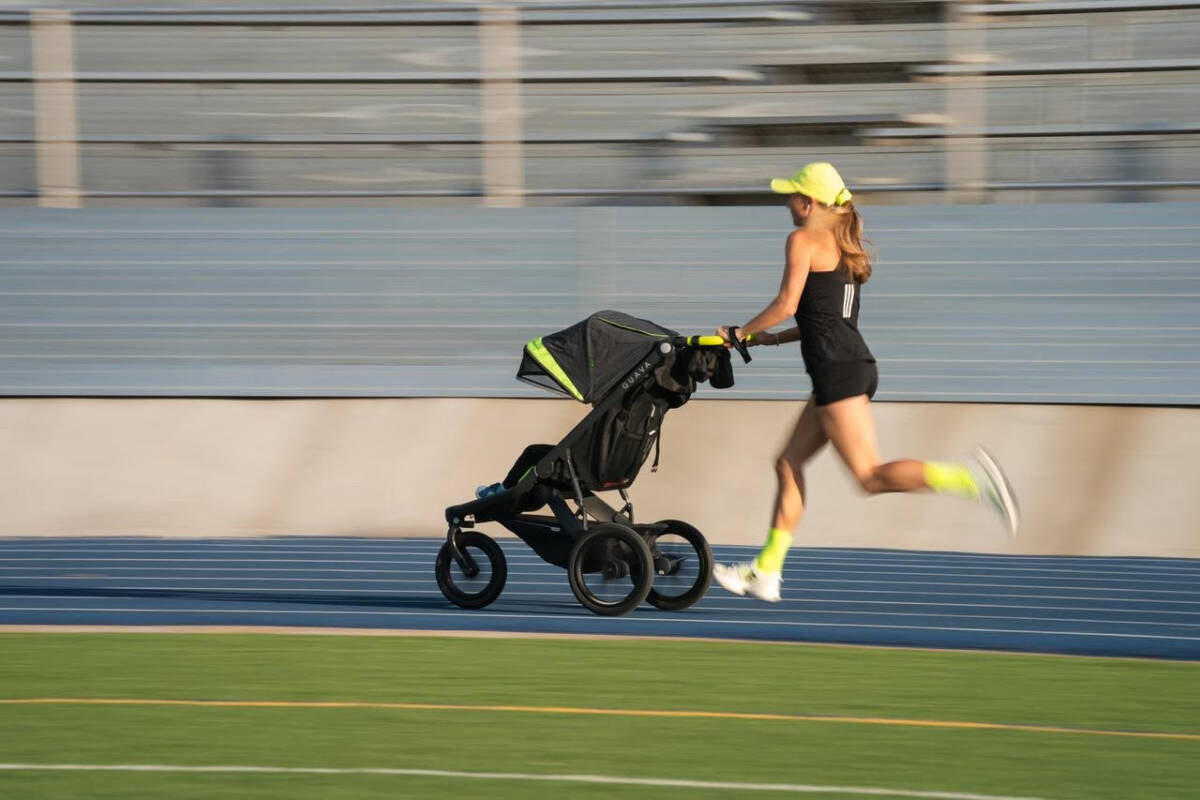Yes, You Can Run with Diastasis Recti!
Diastasis Recti, a widening of the connective tissue between the abdominal muscles that is associated with weakness in the core, is common postpartum. Unlike previously thought, you can run with diastasis recti. Still, it is best to work with a physical therapist to retrain your core to ensure control in high impact exercises.

(Reviewed by Dr. Rita Deering and Dr. Carrie Pagliano, DPT) — Google “running and diastasis recti” and you’d likely be terrified to run. The internet is quick to tell you that running will make it worse and that doing any sort of crunches, planks, or core work is a bad idea.
The internet is behind the science. You can run with diastasis recti (DR or DRA for diastasis recti abdominis), a widening of the connective tissue between the abs due to pregnancy that can cause core weakness postpartum. (Just look at Steph Bruce who has run at a high-level with visible ab widening). But you will want to work with a physical therapist to coordinate your core muscles to control the pressure caused by running and other high-impact exercises.
Skip Ahead
Let’s go!
Download My Free Postpartum Running Plan
I’ve been running with diastasis recti for years
The topic of running with diastasis recti became poignant to me after I was diagnosed with it this year—7 years after having my second child! I started running at a high level about 1.5 years after his birth—including near 100-mile weeks. Soon after, I got injured…and then injured again…and then injured again.
I’ve spent the last 4.5 years battling running injury after running injury. I finally saw a pelvic floor physical therapist who noted during a diastasis recti exam that I have DR below my navel.
I am now working a pelvic floor physical therapist AND a physical therapist who specializes in helping runners to correct the muscle coordination in my core and immobility of my hip, spine, and ankle.
For this article, I consulted Dr. Carrie Pagliano, a pelvic floor physical therapist and women’s health expert, Dr. Rita Deering, a leading researcher in pelvic health at Carroll University, and Dr. Shefali Christopher, also a pelvic floor PT and leading researcher in her field at Tufts University.
Can you run with diastasis recti?
Yes, you can run with diastasis recti. Dr. Pagliano, Dr. Deering, and Dr. Christopher are in agreement that women who have diastasis of the rectus abdominis muscle should not fear movement, as there is no science that validates activities such as running, weightlifting, or core strength make diastasis recti worse.
“Women who are scared and don’t exercise will become weak,” says Dr. Pagliano. “We need to help find the path back to strength and confidence in their own bodies again,” adding that it is paramount for runners to do core work.
Can having Diastasis Recti lead to running injuries?
There is no data to show that DRA makes you more vulnerable to running injuries, says Dr. Deering.
Interestingly, Dr. Deering performed a study of postpartum runners where exercises closed the gap (IRD) below the belly button, and this did not impact running mechanics, including hip drop.
However, there is reason to suspect that having DR can play a role in running injuries.
Dr. Deering’s research has shown that, in the general postpartum population (mixed athletes and non-athletes), those with wider IRD are more fatiguable and weaker than those with a narrow IRD. There is also data that postpartum women with DRA have weaker trunk rotation than postpartum women without DRA. (Trunk rotation is important in the running gait cycle).
“The association between increased IRD and strength/fatiguability gives some rationale to hypothesize that injury risk may be increased in general (not just with running). So it certainly makes a strong case for abdominal muscle training and for gradual increases in exercise volume and intensity,” notes Dr. Deering, who has researched postpartum care recommendations.
How do I know if I have diastasis recti?
There are diastasis recti at-home screening tests like this one where you can look for ab widening of two finger widths (or 2.5 cm or more) in the center of your abs, either above or below the belly button. The most common location of diastasis recti is around the navel. (Get more postpartum screening resources here.)
But the best way to know if you have diastasis recti is to see a pelvic floor physical therapist.
Dr. Pagliano shares that she screens for depth, width, and pressure management, and rules out any hernia concerns. She also performs a readiness screen which includes basic planks and side planks, looking for tensioning issues. She then prescribes a exercise program to help with coordination pressure management recommendations.
I will share I had done at-home tests checking for doming with double leg lifts and lowers and ab separation and passed every one. But an in-person test with a pelvic health expert, I learned I do in fact have DR postpartum.
Does coning mean I have diastasis recti?
If your stomach muscles “cone” or “dome” – round when doing exercises such as an ab crunch instead of staying flat, it doesn’t mean you have diastasis recti. “Coning or doming is just an indicator of pressure taking path of least resistance,” says Dr. Pagliano. “We don’t think it’s pathological.”
What should I do if I have diastasis recti?
If you have diastasis recti, you are not broken, says Dr. Pagliano. In fact, it is extremely common.
If you have diastasis recti, the best thing to do is to work with a pelvic floor physical therapist who will develop a progressive exercise program that will train your abdominal muscles to effectively manage intra-abdominal pressure and abdominal weakness, which are common issues after childbirth.
This blog post is not going to diagnose specific exercises for how to address your DR. I wish it were that easy. The most effective way to retrain your entire core, so that it is strong and can handle pressure effectively, is to work with a PT to get the best exercises for your body.
Here are examples of ab exercises to reestablish the integrity of your core muscles so you better control when running.
- Pelvic Tilts
- Cat cow
- Bicycle with block
- Diaphragmatic breathing
- Toe Taps
Can you prevent having diastasis recti?
Women who have had C-sections or multiple births are more likely to have abdominal separation, shares Dr. Pagliano.
Women who are petite and thin may also be more at risk.
Also, there may be a genetic predisposition for diastasis recti according to one study, as some mid-line collagen make-up may stretch more than others.
Concomitant hernias and previous abdominal surgeries can also put you at risk, notes another study.
Is it important to close the “gap”?
The ab widening of diastasis recti is characterized by a gap aka inter-rectus distance (IRD). For a long time, it was believed that closing the gap was necessary to heal DR and get your core functioning as it should again.
However, Dr. Pagliano and Dr. Deering say that reducing the gap may NOT be necessary for proper functioning. (Though women’s body image suffers if they have a gap, resulting in a bulge or pooch).
Performing ab exercises (for above and below the navel) that focus on controlling intra-abdominal pressure may cause the ab muscles to get larger through hypertrophy which may reduce the gap in some women without surgery. This process can take about six months. Again, Dr. Deering’s research found that this had no impact on running mechanics.
Should you avoid ab exercises if you have diastasis recti?
There are no particular abdominal exercises that you should avoid if you have diastasis recti, advises Dr. Pagliano. Despite what you may read, crossover crunches, bicycle crunches, planks, and sit-ups are not necessarily bad for women with Diastasis Recti.
Personally, when doing these exercises, I modify to ensure my lower abs (transverse abdominus) remain flat and the gap is not deep. This usually means that I keep my head on the ground to avoid doming—helping my core learn how to appropriately manage pressure.
Dr. Pagliano says doing core work is better than not doing any at all out of fear.
“The more we learn about diastasis recti, and see women doing challenging sports and activities without worsening symptoms, the more we can learn about this condition and find answers.”
If you have DR, you are not alone and you are not broken! I hope this article helps you improve your quality of life—and YES! you’re running!! If you want guidance with your running goals including running while pregnant or postpartum, check out my run coaching services.





